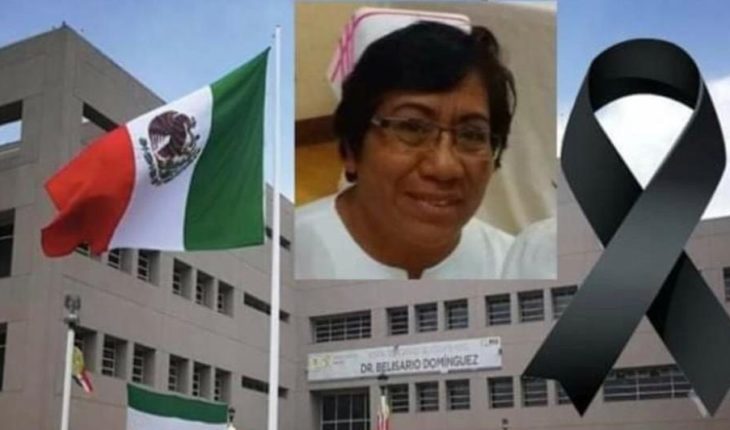Juanita Petra Silva Isidoro, 54, was known by everyone as the “boss Juanita” at the Belisario Domínguez Hospital. There she worked as a nurse for the past 14 years. She was at the helm of Neonatology, Intensive Therapy and, finally, as a supervisor. There, with which he was his team for so many years, he died last Thursday, May 21, the victim of complications arising from COVID-19.
He could have retired in 2019 but decided to stay another year. He liked his work too much. He hoped to finish his career in the area of neonates, the place where he had his first job at Legaria Hospital 32 years ago.
But then came the damn pandemic and all the plans got frustrated.
However, in June they began their pre-retirement proceedings. So he’d be a month before he got a 90-day leave before he said goodbye for good.
COVID-19 caught her earlier.
His body left Belisario Hospital on Friday. He was marching for the last time what was his second home. The coffin was accompanied by the applause of all his companions, who made a human corridor to the exit door.
“Chief Juanita”, another martyr of the coronavirus, a new victim in the collective of hospital workers, men and women who face an unknown pandemic with scarce means and exposed to great risks, had died.
“The sirens sounded and there were all the people: nurses, doctors, quartermasters. Everyone expressed the following so beautiful, so positively, so touchingly about my mother,” says Mayra Laura De Rosa Silva, 28, the eldest daughter of the deceased nurse.
Read: ‘I never imagined, this place was powerful people’: This is the stay of doctors and nurses in Los Pinos
The tribute to Juanita is the symbol of a beaten collective. As of Tuesday 19, there were 11 thousand 394 cases of coronavirus among medical personnel in Mexico, as well as 149 deaths. Among them was not counted the nurse, who died two days later. Each week, the Ministry of Health updates data on victims who leave their lives trying to get others to succeed.
On Sunday, May 24, “Chief Juanita” was buried in the San Lorenzo Tezonco civil Pantheon, right next to the Belisario hospital. “It seems that fate wants it to always be close to the hospital,” says her daughter.
Courtesy
COVID-19 is a cruel disease and loneliness one of its punishments. In his burial, only six people could have been. Her husband, Raúl De Rosa Cueto; her two daughters, Mayra Laura and Juanita Abril, her mother and two brothers.
Two days earlier, the whole hospital had gone out to say last goodbye to one of their own. “The love she gave is the one she receives now. That shows in his farewell. She left, but she turned herself in to the patients until the last day,” Mayra says.
“If there’s one thing I can say, it was delivered until the last moment,” he says.
Vocational nurse and highly respected by her peers
“Sometimes I would ask him, if you were born again, what would you like to have studied? And she would say to me: the same thing.” Mayra, Juanita’s eldest daughter, explains her mother’s vocation. I wanted to be a nurse almost before she was even asked “what do you want to be when you’re older.”
That’s why he studied at the School of Nursing and specialized in child neurology. He never stopped training. He was currently finishing his bachelor’s degree at the University of the South.
He was born in Cuacnopalan, Palmar de Bravo, Puebla, into a humble family. She was the third of nine siblings. His father worked as a bricklayer and his mother worked in the house.
Lee: A man is arrested for discrimination and assault against nurse in Querétaro
His relatives, Mayra says, were the first patients.
“They always supported him. My granny told me that from a little girl she would wear rags, if someone burned her brothers, she would cure them. Then he began his studies and, for example, when he learned to inject he would say a brother, he learns in oranges, then practices with me,” he explains.
He later moved to Tulyehualco, where he created a family with Raul, the man who invited him to dance at a fair, called him “chaparra” and with which he spent his entire life. This year they would have celebrated their thirty years as married.
Courtesy
For 18 years she worked “chief Juanita” at the Legaria Pediatric Hospital. Until 2017, when she moved to Belisario Dominguez and earned the nickname “boss”.
“He was cheerful, I knew you to listen. He was also very professional in his work, optimistic and loyal. A characteristic element of her is that she wore her impeccable uniform, which was always well aligned,” recalls Gladys Santiago Sánchez, current nursing coordinator at the Belisario.
“She was a very dedicated woman. From the salu guildd, the most committed is nursing. It’s the most disciplined team. Juanita was a person who was always in a position to help, scholar, friendly to the staff, quiet,” says Dr. Miguel Angel Toscano, head of the Intensive Therapy area of the Belisario.
The disease is evolving rapidly
No one can determine when “Chief Juanita” was infected. Belisario Dominguez was converted into hospital-Covid19, so it serves only patients with coronavirus. It could have been in one of his rounds in the areas where the sick are. Or that one of his colleagues, also infected, passed him the bug when he went to his office to file a report. There was even a chance he’d gotten sick on the outside. The options are wide in a hospital where staff have repeatedly claimed a shortage of anti-pandemic inputs, a phenomenon replicated to hospitals across the country.
Calixta Concepción Ramos, head of nursing, also fell ill. In addition, of the four nursing supervisors, two were infected.
Read: There are not enough crematoriums in Mexico for the thousands of coVID-19 deaths
“We went together to get tested,” he explains. She still doesn’t think her friend died and has a hard time talking about her in the past.
“On Monday 4 we were already very tired and in the hospital we did not want to do the tests, since there are few and they are for the patients. So a colleague recommended we go to the health center in Tlaltenco,” she says.
They both left there, as soon as they finish their shift.
Two days later they were informed that they were authorized to take the test and soon received the verdict: COVID-19 infection. By then he had isolated himself at home and ISSTE had granted him the one-week disability for possible coronavirus. It was a difficult decision for someone who had “never missed work,” according to his daughter Mayra. But he had no choice. His health was getting worse and, moreover, it was a focus of contagion.
We still know little about this disease. It’s a cruel lottery. She did everything in her hands, but her body wouldn’t respond.
Courtesy
On May 10, Mother’s Day, she received calls from her friends as Calixta Concepción Ramos.
“That was the last day we talked. I was getting better and she was deteriorating,” she says.
On the 12th, International Nurses’ Day, she was admitted to the Belisario. Her daughter Mayra moved her and told her “I love you” before leaving her in the hands of her classmates. “I more, ” replied Juanita, who by then could barely breathe and suffered vision problems.
The pandemic has spread fears of hospital admission. On the street it is said that those who arrive at the medical center have a better chance of losing their life, that you can get infected. Fear and lack of information build irrational explanations.
“Chief Juanita,” however, was aware that going to the hospital was accepting that her condition aggravated and that if people don’t get ahead of it is because the disease has no mercy. But I also knew I was in good hands. That if anyone could get him through, they were his companions.
I had said it repeatedly: “If I get worse, take me to my team. They know what they’re doing and I trust them.”
For nine days and nine nights, her peers, the same ones she worked with for the past 13 years, went out of their way to get her through.
They couldn’t do anything.
On May 15, she was intubated. Six days later, Mayra received the call she would never have wanted to have: her mother’s fever was not falling off, she was having a harder time breathing and had to prepare for the worst.
He had a chance to say goodbye from a glass.
The route to the area of Pathology, where the bodies are kept until the funeral homes arrive, was made the body of the “chief Juanita” surrounded by white robes and with the music of Las Golondrinas. When he left the hospital for good, everyone was there.
The death of a companion is a severe blow to all hospital staff.
“We never imagined this situation. We weren’t ready. We work in isolation on other infectious diseases, but this is different,” says Gladys Santiago.
“I can’t imagine getting there and Juanita not there,” Calixta Concepción Ramos laments.
On Sunday morning, “Chief Juanita” was buried in the San Lorenzo pantheon. Her daughter Mayra remembers her with pride. “If there was a lack of staff in an area, she would come in. There was no day when she didn’t go to see her classmates and she always gave herself to her patients,” she says.
When all this is over, her classmates say they plan to pay homage to him. The last goodbye to the nurse who was supposed to have retired but who died in the hospital where so many lives helped save.
What we do in Animal Político rewants professional journalists, teamwork, dialogue with readers and something very important: independence. You can help us keep going. Be part of the team.
Subscribe to Animal Político, receive benefits and support free journalism #YoSoyAnimal.
translated from Spanish: ‘Chief Juanita’ died of COVID within a month of retiring as a nurse
May 25, 2020 |





